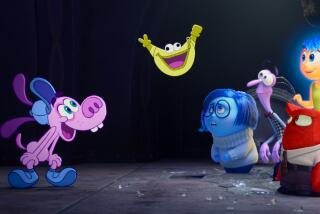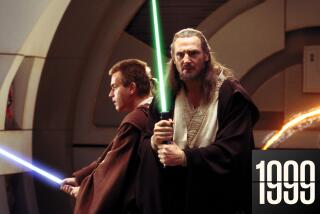Review: Pixar’s ‘Lightyear’ goes to adequacy and not beyond
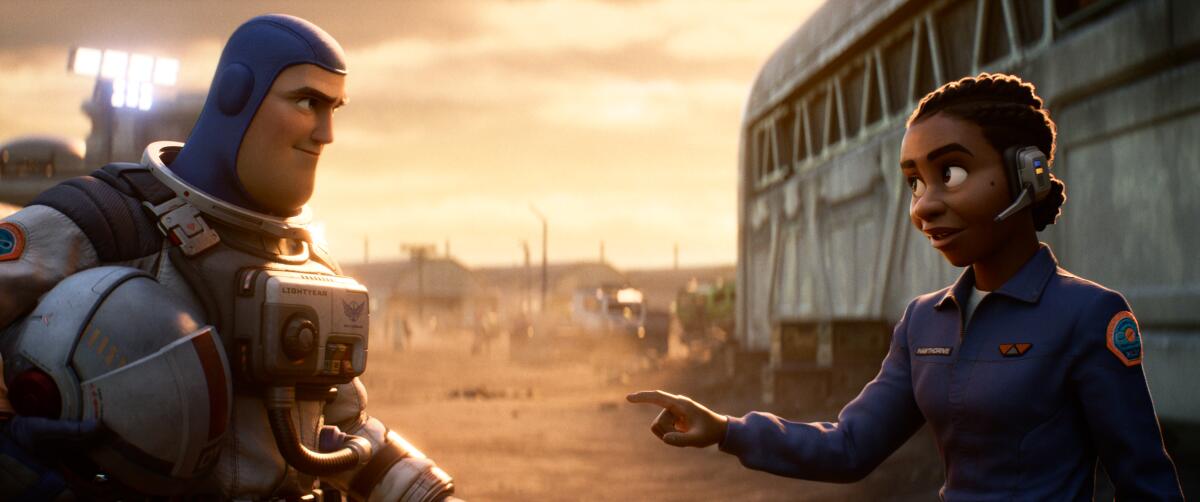
- Share via
In at least one respect, “Lightyear” can claim some distinction: It’s the first Pixar movie ever to be cited as a Pixar character’s favorite movie. There’s more than just brand inflation at work here (though there is also that). In the original “Toy Story,” you’ll recall, a boy named Andy received an action figure of Buzz Lightyear, an intrepid space explorer with pop-out wings, a red laser pointer and an air of genial self-importance summed up by an instant-classic catchphrase (“To infinity … and beyond!”). Now, at the beginning of “Lightyear,” we learn that prized toy was a piece of promotional merchandise for Andy’s favorite film, and that film happens to be “Lightyear” itself.
This is a neat bit of chronological reverse-engineering, a clever way of disguising a feature-length “Toy Story” tie-in as its opposite. It also raises some interesting but probably ignorable questions. Like, what about “Buzz Lightyear of Star Command,” the Disney spinoff series that aired in the early 2000s? Also, why does “Lightyear,” an animated feature supposedly made prior to 1995, look this shiny and state-of-the-art? Shouldn’t it look more like — well, like “Toy Story,” speaking of ’95 releases?
For your safety
The Times is committed to reviewing theatrical film releases during the COVID-19 pandemic. Because moviegoing carries risks during this time, we remind readers to follow health and safety guidelines as outlined by the CDC and local health officials.
A certain aesthetic modesty suited that early Pixar classic, which took place in a couple of suburban kids’ bedrooms and featured an ensemble composed mostly from plastic and fabric. And if “Toy Story’s” visuals seem dated now, especially compared with more recent Pixar movies, that can only have deepened its message about how the things we loved as children inevitably change, because we of course change.
It will be interesting to see how “Lightyear” itself holds up in a quarter-century — just fine, I imagine, and indeed, “just fine” sums up the movie as a whole. Though visually grander and more cosmic in scale than the “Toy Story” quadrilogy, its story feels thinner and more generic. The script, written by Angus MacLane (who makes his feature directing debut here) and Jason Headley, tosses off a few gently mind-bending twists but otherwise rests comfortably within an accessible, highly allusive branch of family-friendly science fiction.
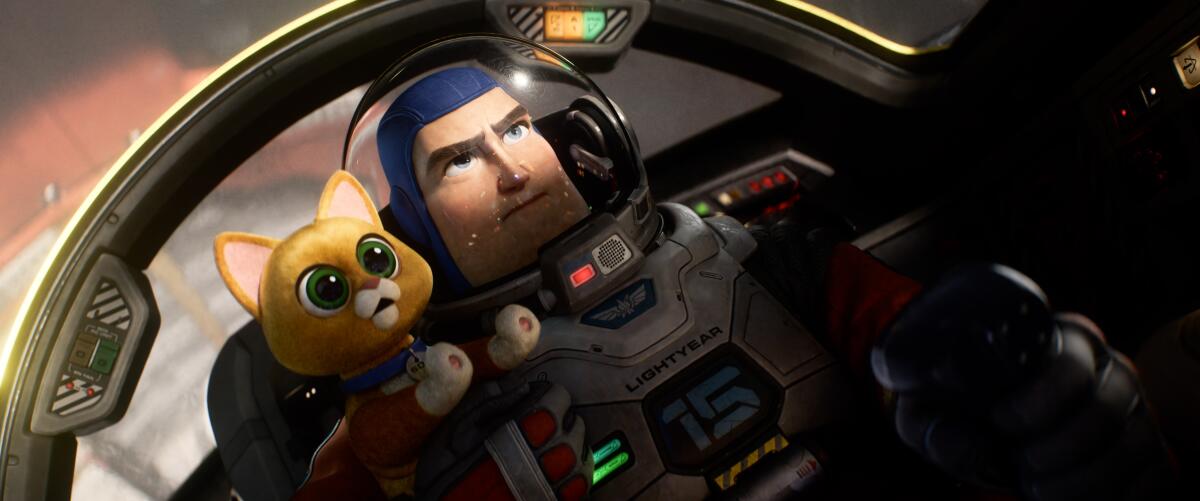
The Buzz Lightyear we see is recognizably Buzz Lightyear, though despite his familiar computer-animated contours, he’s clearly human rather than plastic, with a squarer jaw, more expressive eyes and a full head of brown hair beneath his purple balaclava. (He also speaks in the deeper-than-usual voice of Chris Evans, channeling some of Captain America’s get-it-done spirit while nicely approximating the timbre of a younger Tim Allen.) This is no toy story, in other words, even if one of Buzz’s many sidekicks is a talking cat robot named Sox (voiced by Peter Sohn).
But that’s getting ahead of the plot, which already boasts so many temporal loop-de-loops that it frequently gets ahead of itself. During a long Space Ranger mission, Buzz takes an unplanned detour and winds up crash-landing his ship and a sizable raft of humanity on an unfriendly planet. There, hostile giant insects swarm about, and hungry, tensile vines are forever threatening to drag outsiders beneath the otherwise barren surface. Buzz, who blames himself for this turn of events, is determined to get everyone home; to do so, he’ll need to harness a rare crystal-based fuel source that will enable the requisite leap to hyperspeed.
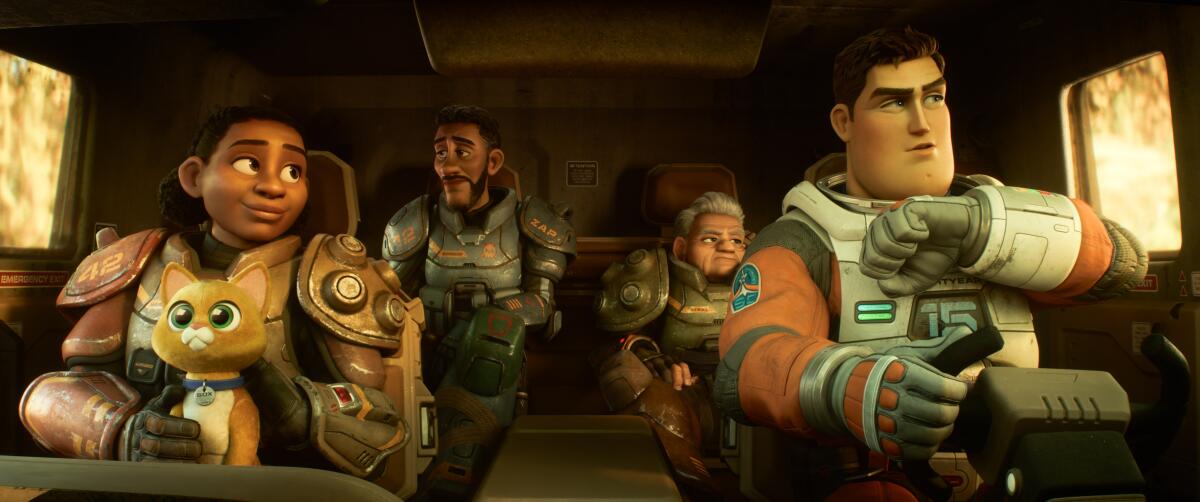
Testing this fuel will require Buzz to fly a series of missions, each one lasting only four minutes for him but, due to some clever time-dilation principles, a few years for those waiting patiently for him back on terra firma. And so, like the brave astronauts in “Interstellar” — or the unwitting young time traveler in “Flight of the Navigator” — Buzz must grapple with the painful conundrum of aging more slowly than those he loves. Chief among these is Alisha Hawthorne (Uzo Aduba), his fellow Space Ranger and closest confidante. She’s granted an accelerated blip of a life story — over six decades she finds a wife, has a son and becomes a grandmother — that achieves some of the emotional sublimity of the “Married Life” montage from “Up.”
In this case, though, the poignancy derives from the fact that Buzz misses out on almost all of it, being too absorbed with his mission to open his eyes and appreciate the living of life and the passage of time. (It also derives from the welcome presence of a significant Black LGBTQ character in a studio-animated feature, another reason why “Lightyear” doesn’t seem terribly 1995.) And so, despite the grandeur of this movie’s cosmos — at once vast and derivative enough to trigger memories of “2001,” “Star Trek,” “Gravity” and, yes, “Wall-E” — “Lightyear” ultimately hews to a thematic rubric that Pixar fans will recognize from the more earthbound worlds of “Finding Nemo,” “The Incredibles” and “Inside Out.” Like those earlier classics, it’s both an adventure and an ego check, a reminder that true heroism means learning to relinquish control, embrace unpredictability and recognize the value of others.
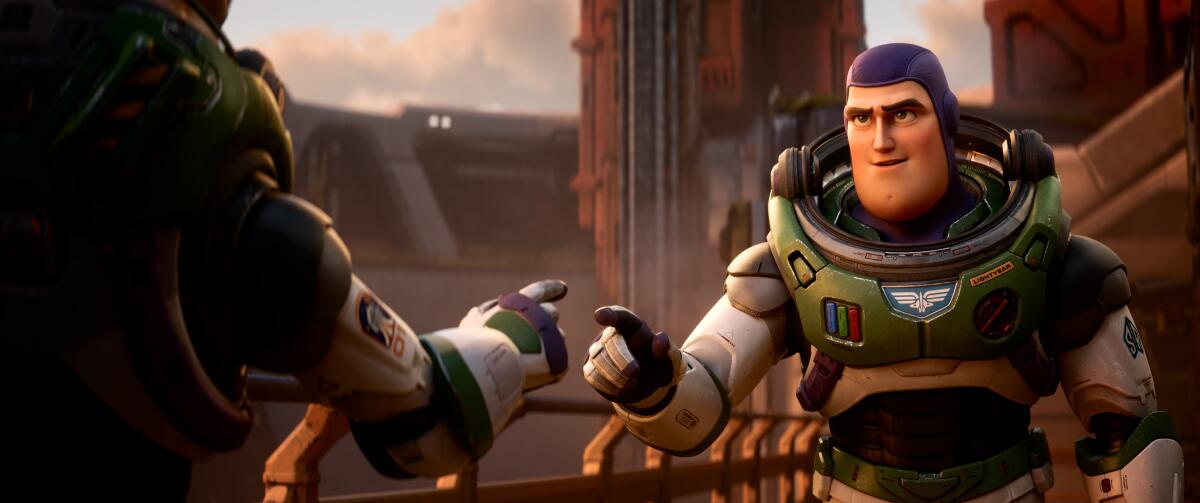
One day in a different universe, of course, action figure Buzz Lightyear will teach a cowboy doll named Woody some of those same lessons. In “Lightyear,” they are imparted by a ragtag team of misfits determined to aid Buzz in his mission, including a friendly bumbler (Taika Waititi), a crusty ex-con (Dale Soules) and Alisha’s granddaughter, Izzy (Keke Palmer), untested but eager to prove herself worthy of the Hawthorne Space Ranger legacy. And yes, there’s also Sox, a futuristic emotional-support animal designed to ease Buzz’s trauma, and also to bring doses of whimsy and cuteness — to strike a note of “aww” — amid all the noise and action.
Of which there is quite a lot, in keeping with the zippy, high-energy Pixar brand. There are robot armies, laser shields, zero-gravity adventures and more stolen jets than in “Top Gun: Maverick.” There is also Buzz’s famous purple-armored nemesis, the evil Emperor Zurg (voiced by James Brolin), whose underlying motivation here turns out to be a pretty good surprise. To the extent that anything in “Lightyear” can really be called surprising, that is. It’s a film of modest charms and secondhand pleasures, enough to help pass a summer afternoon, if not to quell the sense that it was made for less-than-creative reasons. I do hope Andy eventually saw “Ratatouille.”
'Lightyear'
Rating: PG, for action/peril
Running time: 1 hour, 45 minutes
Playing: Starts June 17 in general release
More to Read
Only good movies
Get the Indie Focus newsletter, Mark Olsen's weekly guide to the world of cinema.
You may occasionally receive promotional content from the Los Angeles Times.
